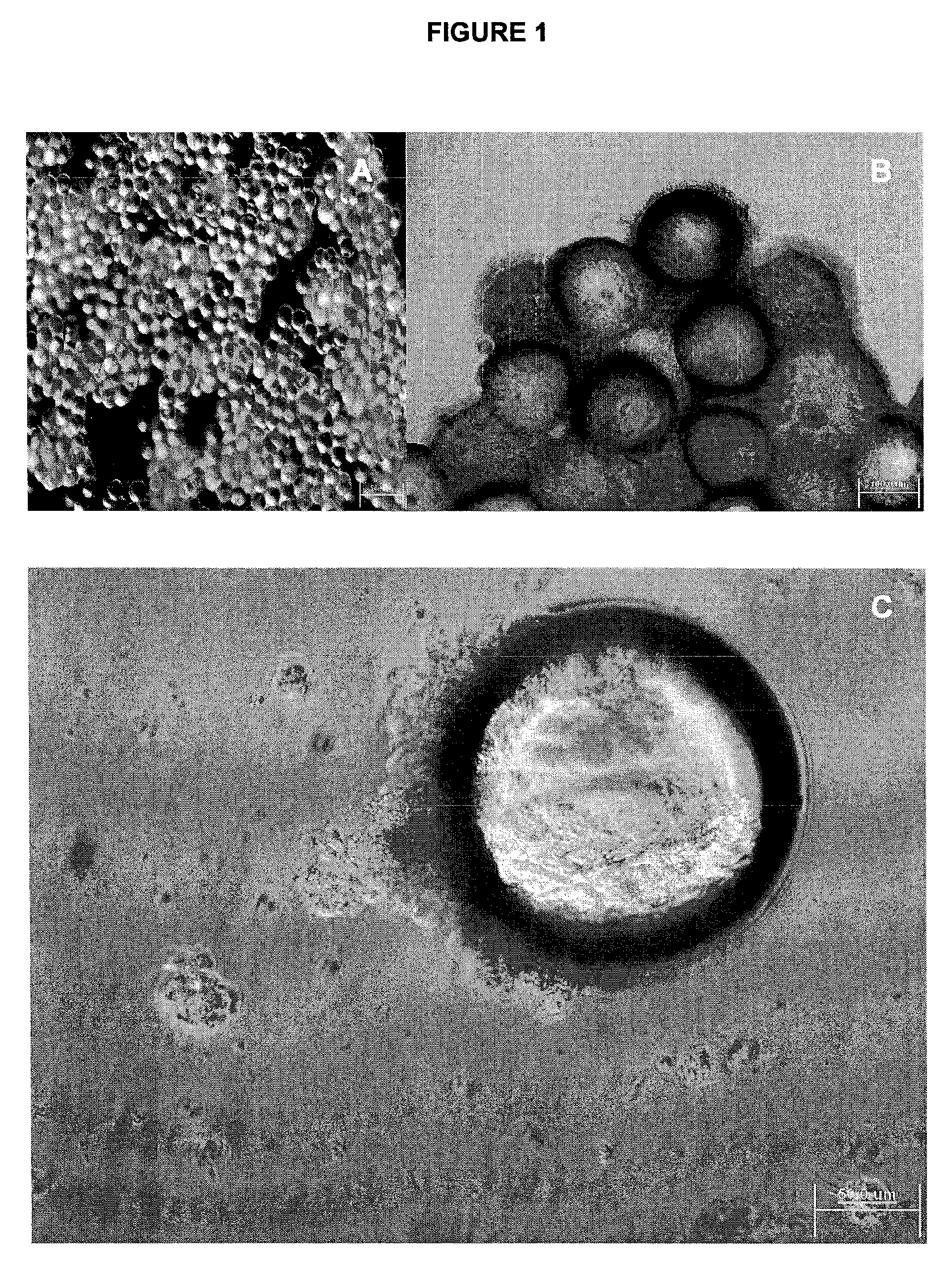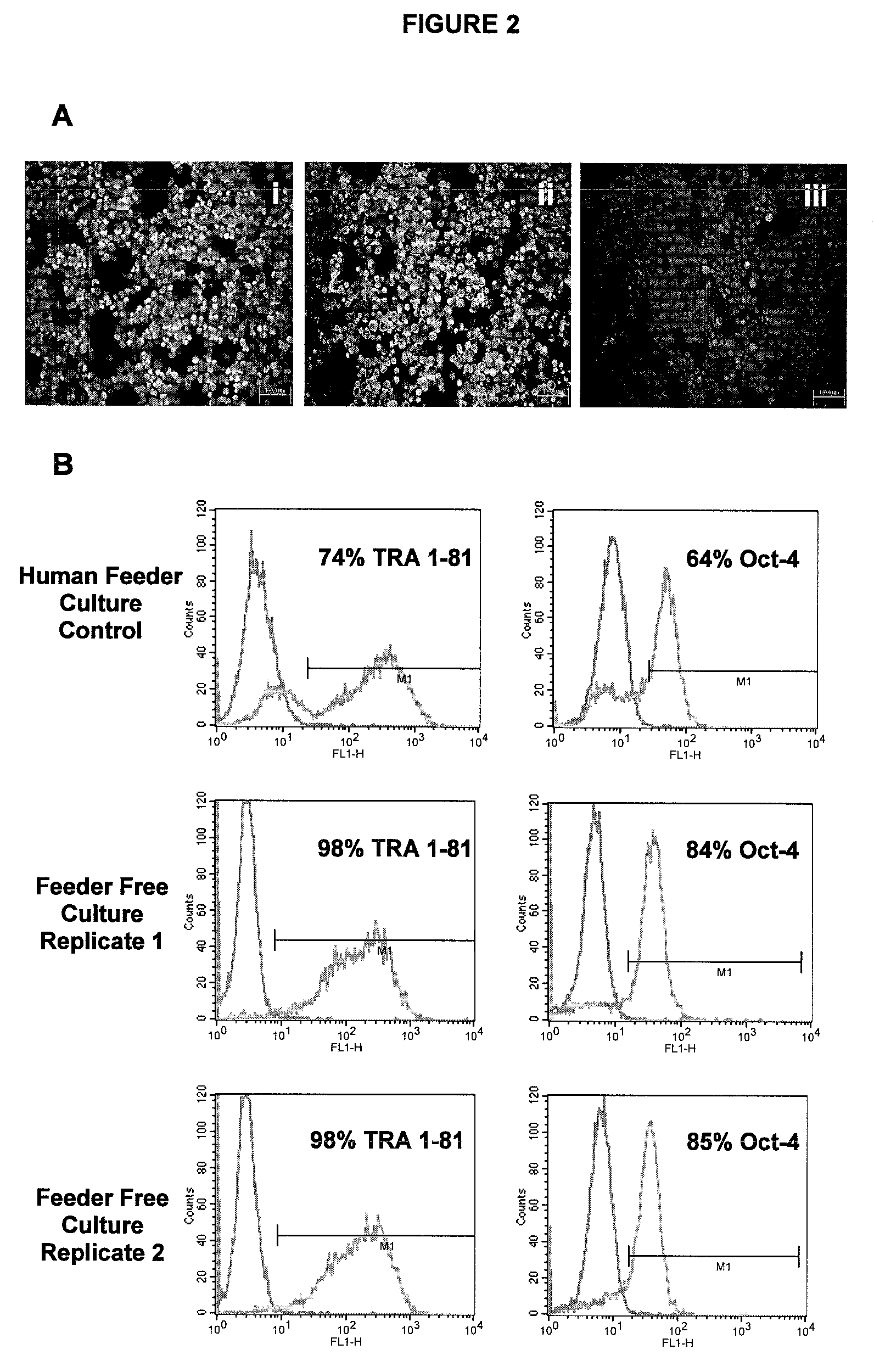Method for stem cell culture and cells derived therefrom
a stem cell culture and cell technology, applied in the field of stem cell culture and cells derived therefrom, can solve the problems of significant limitations and drawbacks of the procedures currently employed, and achieve the effects of reducing the need for using potential contaminants, and reducing the need for stem cell composition contamination
- Summary
- Abstract
- Description
- Claims
- Application Information
AI Technical Summary
Benefits of technology
Problems solved by technology
Method used
Image
Examples
example 1
Morphological Analysis of hES Cell Culture following Propagation on Cationic Amine Tri-Methylamine Coated Microcarriers
[0107]All microcarrier experiments were performed using Hillex II cationic tri-methylamine coated microcarriers (SoloHill Engineering, Inc.). Human ESC, hES-2 (http: / / stemcells.nih.gov / research / registry / esci.asp) were propagated on microcarriers in flat bed culture plates (see panel A of FIG. 1) or in bulb stirred culture vessels (see panels B and C of FIG. 1). Cells were passaged using Collagenase IV disaggregation and collected for subsequent seeding to fresh beads. Cultures were maintained in human fibroblast feeder conditioned media comprising Invitrogen KO-DMEM supplemented with 25 ng / mL bFGF, 20% Invitrogen KO-SR, 0.1 mM β-mercaptoethanol, 1% NEAA, 2 mM L-glutamine, 25 U / mL penicillin, and 25 μg / mL streptomycin. Following conditioning, media was further supplemented with additional 25 ng / mL bFGF. The cultures comprised small uniform clumps of cell-coated beads...
example 2
Immunohistochemical Analysis of hES Cells following Propagation on Cationic Amine Tri-Nethylamine Coated Microcarriers
[0108]hES-2 hES cells were propagated for 7 days on microcarriers in flat bed culture plates. Cultures were maintained in human fibroblast feeder conditioned media comprising Invitrogen KO-DMEM supplemented with 25 ng / mL bFGF, 20% Invitrogen KO-SR, 0.1 mM β-mercaptoethanol, 1% NEAA, 2 mM L-glutamine, 25 U / mL penicillin, and 25 25 μg / mL streptomycin. For immunophenotyping, cells were harvested from microcarriers using Collagenase IV disaggregation, cytospun to glass slides and fixed for immunohistochemistry. Cells were fixed with 4% paraformaldehyde and stained for Oct-4 (i; Santa Cruz Biotechnology), TRA 1-81 (ii; Chemicon) or SSEA-1 (iii; Chemicon) (FIG. 2A). The data confirms the maintenance of undifferentiated hES cells, thus verifying the efficacy of chosen method.
example 3
Flow Cytometric Analysis of hES Cells following Propagation on Cationic Amine Tri-Methylamine Coated Microcarriers
[0109]hES-2 hES cells were propagated on microcarriers in bulb stirred culture vessels. Cells were passaged using Collagenase IV disaggregation and collected for subsequent seeding to fresh beads. Cultures were maintained in human fibroblast feeder conditioned media comprising Invitrogen KO-DMEM supplemented with 25 ng / mL bFGF, 20% Invitrogen KO-SR, 0.1 mM β-mercaptoethanol, 1% NEM, 2 mM glutamine, 25 U / mL penicillin, and 25 μg / mL streptomycin. Following conditioning, media was further supplemented with additional 25 ng / mL bFGF. Cells were fixed with 4% paraformaldehyde and stained for Oct-4, TRA 1-81 (Chemicon) and analysed by flow cytometry. Relative to negative controls (i.e. isotype antibody labelling; see FIG. 2B, left-hand pink open plots), cells sustained high level expression (see FIG. 2B, right-hand blue open plots) of both markers, indicating undifferentiated h...
PUM
| Property | Measurement | Unit |
|---|---|---|
| volume | aaaaa | aaaaa |
| density | aaaaa | aaaaa |
| total volume | aaaaa | aaaaa |
Abstract
Description
Claims
Application Information
 Login to View More
Login to View More - R&D
- Intellectual Property
- Life Sciences
- Materials
- Tech Scout
- Unparalleled Data Quality
- Higher Quality Content
- 60% Fewer Hallucinations
Browse by: Latest US Patents, China's latest patents, Technical Efficacy Thesaurus, Application Domain, Technology Topic, Popular Technical Reports.
© 2025 PatSnap. All rights reserved.Legal|Privacy policy|Modern Slavery Act Transparency Statement|Sitemap|About US| Contact US: help@patsnap.com



